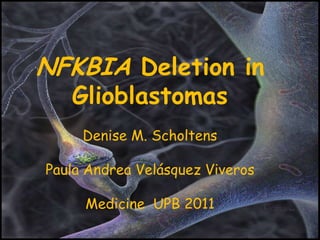
NFKBIA Deletion in Glioblastomas Linked to EGFR Pathway Activation
- 1. NFKBIA Deletion in Glioblastomas Denise M. Scholtens Paula Andrea Velásquez Viveros Medicine UPB 2011
- 2. INTRODUCTION
- 3. INTRODUCTION GLIOBLASTOMA Tumors are named for the cell types from which they originate. Glioblastomais the general name for a tumor that arises from the glial tissue, which supports and nourishes the brain.
- 4. INTRODUCTION GLIOBLASTOMA There are several different kinds of glial cells: astrocytes, oligodendrocytes and ependymal cells. Oligodendrocytes Astrocytes Ependymal cells
- 5. INTRODUCTION GLIOBLASTOMA MULTIPLE Is a malignant astrocytoma that contains areas of dead tumor cells. Gliosarcoma and giantcellglioblastoma are variants of glioblastoma multiforme. Approximately 50% of astrocytomas are glioblastomas.
- 6. INTRODUCTION GLIOBLASTOMA MULTIPLE Glioblastomas contain more than one cell type. While one cell type may die off in response to a particular treatment, the other cell types may continue to multiply. It makes very difficult the treatment.
- 7. INTRODUCTION EPIDERMAL GROWTH FACTOR Is a small mitogenic protein that is thought to be involved in mechanisms such as normal cell growth, oncogenesis, and wound healing. It’s over produced in tumors. EGFR pathway actives NFKB.
- 8. INTRODUCTION
- 9. RELATION When it is inactive, NF-KB is located in the cytoplasm. Whereas, it is active is transported to the nucleus, where it gets in contact with EGFR and increased its action. In tumor cells, the NFKB can induce cellular proliferation
- 10. RELATION The increased signal in the tumor's cells sent by the EGFR actives the NF-kappa-B receptor, causing the appearance of cancer, in this case, the multiple glioblastoma and the chemotherapy resistance.
- 11. EGFR NUCLEUS NFKBIA NFKB WITHOUT NFKB DELETION
- 12. EGFR NUCLEUS NFKB NFKB DELETION
- 14. GENERAL OBJECTIVE: AnalyzeNFKBIA deletion in glioblastomas
- 17. Tipos de datos: G= Datos del número de copia del gen E= Datos de expresión génica C= Datos clínicos M= O6 metilguanina DNA metiltransferasa S= Secuencia de datos (MGMT)
- 18. LÍNEAS CELULARES Y PREPARACIÓN DEL DNA GENÓMICO
- 20. INMUNOBLOT
- 21. APLICACIÓN DEL INMUNOBLOT Se realizó en el estudio para hallar en los pacientes la presencia del gen NFKBIA. Se sometieron las líneas celulares en SDS, cargado negativamente. De esa manera, se separaron las proteínas según su tamaño y su carga.
- 22. RESULTADOS
- 23. RESULTADOS En la unidad 1, se tomaron 219 glioblastomas, donde el 24,2% poseen deleción a NFKBIA. se afecta el cromosomas 14, el brazo corto en el loci 13.
- 24. RESULTADOS La dosis génica se asigna, según la ubicación del cromosoma. La supresión de NFKBIA se asocia a una pérdida significativa de expresión en los 175 glioblastomas en el estudio de un conjunto donde se habían combinado los datos de genes.
- 25. RESULTADOS Se han distinguido en diferentes estudios, varios subtipos de glioblastomas, como son: clásicos, mesenquimales, neuronales y proneuronales. Donde hay delación en mayor frecuencia en los proneuronales. Las amplificaciones de EGFR son mas comunes en los glioblastomas clásicos. Lo que indica exclusividad para la deleción de NFKBIA y amplificación de EGFR.
- 26. RESULTADOS Se miraron 3 pacientes. Paciente 1: hay disminución en la acción de NFKBIA. Paciente 2: hay un poco de aumento en NFKBIA, sin importar que haya amplificación de EGFR. Paciente 3: NFKBIA tiene acción en un 100%, ya que hay presencia de este y EGFR no está amplificándose.
- 27. DISCUSSION
- 28. DISCUSSION
- 29. CONCLUSSION
- 30. CONCLUSSION NFKBIA deletionallowsthat NFKB goestonucleus, and it can increase EGFR action, enhacingcellproliferation Analyzingthefour molecular subtypes of glioblastoma, theresearchfoundthat NFKBIA deletion and EGFR amplificationhaveanspecial exclusive foronlyonesubtype.
- 31. CONCLUSSION The researches of the NFKBIA gene, whose absence causes biological situations similar to the increase of EGFR, contributes to the development of possible solutions to glioblastomas and its Resistance to treatment with temozolamide. In future researches, It will be taken into account not only the alteration of NFKBIA as an inductor of brain neoplasicprocesses. It will be taken into account too the fact that the gene alteration can be found in some variety of tumors such as Hodking lymphoma, Multiple myeloma, melanoma or breast, lung and colon cancer, seeking for efective treatments with bortezomib
- 32. MAPA CONCEPTUAL
- 34. GRACIAS